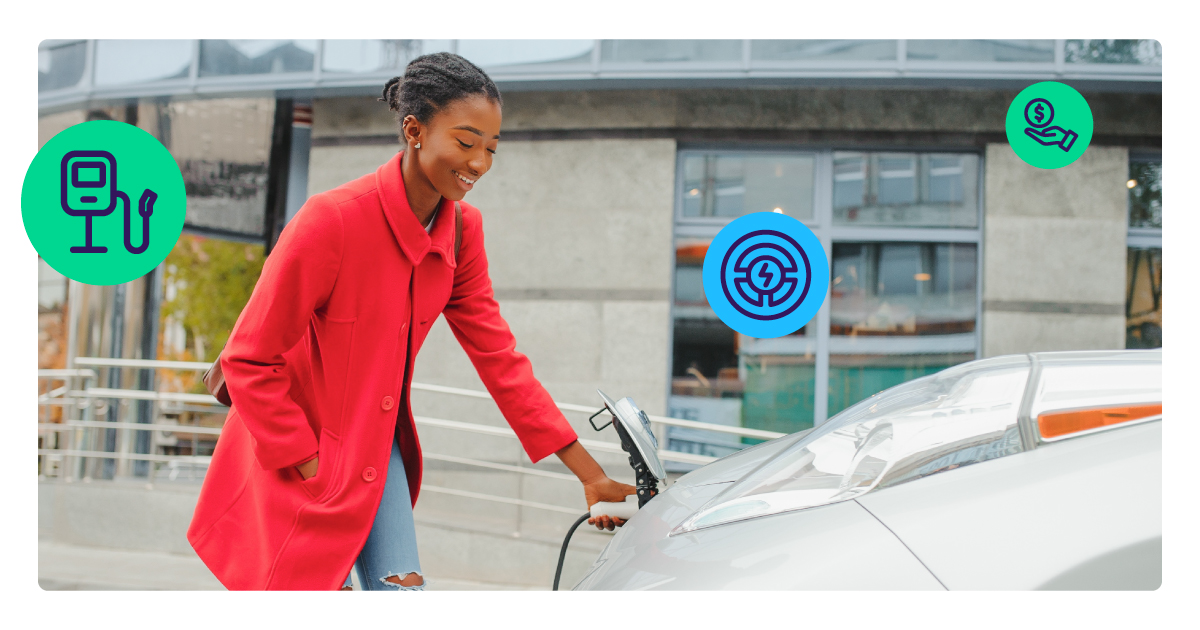Digital payments play a significant role in public electric vehicle (EV) charging. Unfortunately, existing EV payment systems are falling well short of the invisible, frictionless payment experiences drivers expect.
Poor payment experiences damage the customer experience and hurt consumer perceptions of EV reliability. They also create barriers to adoption. As the EV industry and governments push to accelerate consumer adoption, the issues with EV charger payment systems need to be addressed.
Thankfully, there’s a huge opportunity for payment providers that can find ways to make charger payments better — especially in the United States, where nearly 1.2 million public chargepoints will be required to serve the estimated 33 million EVs on American roads by 2030.
So, why does payments technology matter so much for EV adoption? How big is the reliability problem? And what can payments providers do to improve the experience for both station owners and drivers? Let’s break it down.
Reliable Infrastructure Is Key to Wider EV Adoption
Over the past decade, boosting EV adoption has been a top priority for both car makers and governments worldwide. While U.S. infrastructure programs are currently on pause, the last five years have brought major progress. Public EV charger availability has doubled since 2020, reaching around 61,000 stations nationwide, and today, 64% of Americans live within two miles of a public charging station. That proximity matters: people who live near public charging stations are significantly more likely to view EVs positively and consider buying one in the future.
Despite solid progress in charging network coverage, Americans are still concerned about access to reliable EV infrastructure. According to Consumer Reports, range anxiety — the fear that an electric vehicle won’t have enough battery to reach a destination or charging point— remains the leading concern for potential EV buyers, with 49% of survey respondents citing it as their top worry.
What that means is American car shoppers still don’t really trust EVs to get them to where they need to go on longer-distance trips, both because of limited range and a perceived lack of places to stop and charge. Until that trust gap is closed, EV adoption won’t reach its full potential.
EV Charger Payments System Failures Are a Critical Pain Point
A 2022 audit of public EV fast charging stations in the San Francisco area found that 27.5% were nonfunctional. One of the main culprits: payment failures. Of those nonfunctional chargers, 7.2% experienced a complete payment system failure that wouldn’t let the driver pay with any of the tested methods, including membership apps. And a staggering 24.5% failed to accept multiple credit card providers.
A separate study performed by the California Air Resources Board found that over 16% of survey respondents had experienced payments issues at a public charging station. These failure rates are unacceptably high, reinforcing growing consumer concerns about the reliability and availability of charging infrastructure.
Of course, a lot has changed in the last three years, including the widespread dominance of tap payments. But what these studies show us is that the nature of EV chargers — which are unattended, often exposed to the elements 24/7 and may be located in areas of weak network strength — makes payment hardware more prone to issues and less likely to be quickly resolved.
How Many Attempts To Pay Are Too Many?
In the 2022 audit, testers used two credit cards. The first card was inserted and, if the dip failed, it was swiped. A subsequent swipe failure led to the same procedure with the second card. If both cards failed, a mobile app or a charging network membership card was tried.
Out of 375 chargers tested, only 50.4% worked on the first credit card dip. In total, 24.5% failed to accept any of the four payment card attempts.
Today, tap is the dominant option. But the fact that almost a quarter of chargers failed to take any of the four card attempts demonstrates that exposed, unattended and unmonitored payments hardware is a potential weak link in EV chargers that needs to be improved.
Because, if drivers are being forced to try a second payment method, that’s likely one of the worst payments experiences they face as consumers, which is a big problem for everyone involved, including the payment providers powering those chargers.
The Opportunities To Improve EV Charging Payments
The EV industry is looking to supercharge adoption, especially in the United States, which lags well behind places like the European Union and China. That will require a significant increase in the number of chargers and equally big improvements in their reliability.
At the same time, largely untapped markets like retail stores with large parking lots are slowly coming around to the benefits of offering charging stations. That means EV charging payments represent a huge opportunity for payment companies that can find ways to serve both infrastructure owners and their end customers better.
So, how can payment providers solve some of the payments problems currently plaguing EV chargers? Best practices for public charging station payments call on infrastructure hosts and payment providers to focus on several key areas, including:
- Network connectivity
- Integration and installation
- Hardware Durability
- Customer experience
- Interoperability
Improve Network Connection Stability and Redundancy
A data connection is necessary for transmitting payment information and returning an authorization to activate charging hardware. But poor connectivity is a common problem that leads to payment issues, especially in rural areas of the United States, where mobile network connections can be spotty at best.
Here are some best practices for ensuring EV charger payment systems always have network connectivity:
- Use redundant network connections: Use solutions like dedicated and backup SIM cards for cellular data connection, hardwired Ethernet connections, and Wi-Fi backup connections where chargers are near a secure host network (i.e. retail parking lots)
- Add external antennas: Install external antennas on EV chargers to strengthen the signal to the payments hardware.
- Enable Wi-Fi hotspot options for customers: Allow customers to use their phones to pay via apps by offering Wi-Fi hotspot capabilities, creating a backup connection from the customer side
Simplify Charger Payments Integration
EV charging stations are generally unattended, and in some cases, they are in remote locations. Unlike in-store payment systems, there’s rarely someone on-site to troubleshoot issues or help with technical problems. That makes flawless integration and reliable payment hardware absolutely essential.
Best practices for improving integration and installation include:
- Using skilled integration specialists: Provide highly trained integration specialists to manage payment deployment for the charging station owner
- Choosing compatible hardware: Make sure the payment hardware is fully compatible with an EV charging station’s software
- Using easy-to-integrate EV POS software: Select point-of-sale (POS) software that’s been designed to integrate with a wide variety of EV charging payment devices
- Testing everything before launch: Thoroughly test hardware and software integrations prior to deployment
- Double-checking activation details: Confirm that activation information — like terminal IDs and station locations — is accurate
- Supporting PCI compliance: Provide initial and ongoing assistance with maintaining Payment Card Industry (PCI) compliant hardware and connections
- Offering Incremental Authorization: Enable chargers to automatically reauthorize the payment amount as the charge progresses, rather than pre-authorizing a large amount upfront.
Promote More Robust Hardware
EV charging payments hardware often lives outdoors, where it can be exposed to extreme conditions 24/7. From rain and snow to extreme heat and cold to dust and debris, unattended EV payment systems need to be built tough to withstand the worst and continue functioning.
In addition to the weather, chargers are frequently vandalized for their copper cables. This costs operators over $5,000 per charger, making durable hardware a crucial part of building and maintaining charging infrastructure.
Here are some best practices for deploying more robust charging hardware:
- Use weather-resistant payment devices: Choose weather-resistant card readers and NFC tap systems with IP54 or IP66 ratings against dust and water penetration
- Embed tap pads in the charger: Build contactless tap pads directly into the charger casing to minimize exposure and gaps where dust or water could enter
- Install smart card readers: Use card readers that can detect extreme heat and automatically shut down until a customer interacts with them, helping prevent overheating
- Avoid direct sunlight: Position card readers away from direct sunlight wherever possible
- Monitor for malfunctions and tampering: Set up systems that send back-end error alerts whenever hardware malfunctions occur or chargers are tampered with
Improve the Payments Experience for Drivers
Because EV chargers are typically unattended, the entire experience (including payment) needs to be simple and intuitive. If a customer can’t pay, they can’t charge. At best, that’s frustrating; at worst, it’s dangerous. Payment systems need to be user-friendly and easy to navigate — even for less tech-savvy drivers.
Best practices for improving the payments experience for users include:
- Clearly displaying payment instructions: Make sure instructions are displayed prominently on the charging station or on the user interface screen
- Using durable QR code displays: Show QR codes directly on the terminal screen or use more durable materials than traditional stickers, which fade and peel
- Providing digital receipts: Ensure that digital receipts are delivered via text, email or the web if paper receipts are not available
- Ensuring accessibility: Position payment systems at a height and angle that are accessible to all users
- Offering Multiple Payment Options: Support the maximum number of payment options possible — dip, swipe and tap card payments, QR code payments, apps, “plug & charge” and toll-free call or text options — to ensure customer choice and convenience.
- Maximizing Interoperability: Utilize new protocols to create more interoperable networks. Open Charge Point Protocol (OCPP) is the industry standard for communication between chargers and charging station management systems (CSMS). But additional protocols like Open Charge Point Interface (OCPI) can be combined with OCPP to create roaming-enabled networks that maximize driver choice.
NMI offers a full suite of hardware ideally suited to integrate reliable tap, dip, swipe and digital wallet payments into unattended EV charging stations. We also offer mobile solutions to power frictionless in-app member payments for networks of all sizes. Regardless of what types of EV charging merchants you serve, NMI has the technology and the experience to enable you to serve them better.
To find out more about how NMI can help you take advantage of the growing EV market, reach out to a member of our team today.





